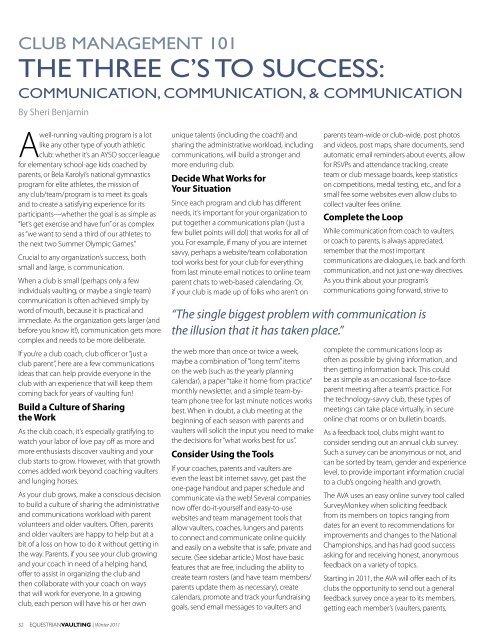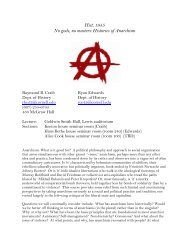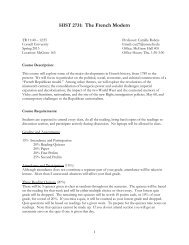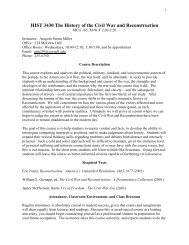VaultinG - Cornell University Department of History
VaultinG - Cornell University Department of History
VaultinG - Cornell University Department of History
Create successful ePaper yourself
Turn your PDF publications into a flip-book with our unique Google optimized e-Paper software.
cluB mAnAgement 101<br />
the three c’s to success:<br />
communicAtion, communicAtion, & communicAtion<br />
By Sheri Benjamin<br />
A<br />
well-running vaulting program is a lot<br />
like any other type <strong>of</strong> youth athletic<br />
club: whether it’s an AYSO soccer league<br />
for elementary school-age kids coached by<br />
parents, or Bela Karolyi’s national gymnastics<br />
program for elite athletes, the mission <strong>of</strong><br />
any club/team/program is to meet its goals<br />
and to create a satisfying experience for its<br />
participants—whether the goal is as simple as<br />
“let’s get exercise and have fun” or as complex<br />
as “we want to send a third <strong>of</strong> our athletes to<br />
the next two Summer Olympic Games.”<br />
Crucial to any organization’s success, both<br />
small and large, is communication.<br />
When a club is small (perhaps only a few<br />
individuals vaulting, or maybe a single team)<br />
communication is <strong>of</strong>ten achieved simply by<br />
word <strong>of</strong> mouth, because it is practical and<br />
immediate. As the organization gets larger (and<br />
before you know it!), communication gets more<br />
complex and needs to be more deliberate.<br />
If you’re a club coach, club <strong>of</strong>ficer or “just a<br />
club parent”, here are a few communications<br />
ideas that can help provide everyone in the<br />
club with an experience that will keep them<br />
coming back for years <strong>of</strong> vaulting fun!<br />
Build a Culture <strong>of</strong> Sharing<br />
the Work<br />
As the club coach, it’s especially gratifying to<br />
watch your labor <strong>of</strong> love pay <strong>of</strong>f as more and<br />
more enthusiasts discover vaulting and your<br />
club starts to grow. However, with that growth<br />
comes added work beyond coaching vaulters<br />
and lunging horses.<br />
As your club grows, make a conscious decision<br />
to build a culture <strong>of</strong> sharing the administrative<br />
and communications workload with parent<br />
volunteers and older vaulters. Often, parents<br />
and older vaulters are happy to help but at a<br />
bit <strong>of</strong> a loss on how to do it without getting in<br />
the way. Parents, if you see your club growing<br />
and your coach in need <strong>of</strong> a helping hand,<br />
<strong>of</strong>fer to assist in organizing the club and<br />
then collaborate with your coach on ways<br />
that will work for everyone. In a growing<br />
club, each person will have his or her own<br />
32 EquEstrian<strong>VaultinG</strong> | Winter 2011<br />
unique talents (including the coach!) and<br />
sharing the administrative workload, including<br />
communications, will build a stronger and<br />
more enduring club.<br />
Decide What Works for<br />
Your Situation<br />
Since each program and club has different<br />
needs, it’s important for your organization to<br />
put together a communications plan (just a<br />
few bullet points will do!) that works for all <strong>of</strong><br />
you. For example, if many <strong>of</strong> you are internet<br />
savvy, perhaps a website/team collaboration<br />
tool works best for your club for everything<br />
from last minute email notices to online team<br />
parent chats to web-based calendaring. Or,<br />
if your club is made up <strong>of</strong> folks who aren’t on<br />
the web more than once or twice a week,<br />
maybe a combination <strong>of</strong> “long term” items<br />
on the web (such as the yearly planning<br />
calendar), a paper “take it home from practice”<br />
monthly newsletter, and a simple team-byteam<br />
phone tree for last minute notices works<br />
best. When in doubt, a club meeting at the<br />
beginning <strong>of</strong> each season with parents and<br />
vaulters will solicit the input you need to make<br />
the decisions for “what works best for us”.<br />
Consider Using the Tools<br />
If your coaches, parents and vaulters are<br />
even the least bit internet savvy, get past the<br />
one-page handout and paper schedule and<br />
communicate via the web! Several companies<br />
now <strong>of</strong>fer do-it-yourself and easy-to-use<br />
websites and team management tools that<br />
allow vaulters, coaches, lungers and parents<br />
to connect and communicate online quickly<br />
and easily on a website that is safe, private and<br />
secure. (See sidebar article.) Most have basic<br />
features that are free, including the ability to<br />
create team rosters (and have team members/<br />
parents update them as necessary), create<br />
calendars, promote and track your fundraising<br />
goals, send email messages to vaulters and<br />
parents team-wide or club-wide, post photos<br />
and videos, post maps, share documents, send<br />
automatic email reminders about events, allow<br />
for RSVPs and attendance tracking, create<br />
team or club message boards, keep statistics<br />
on competitions, medal testing, etc., and for a<br />
small fee some websites even allow clubs to<br />
collect vaulter fees online.<br />
Complete the Loop<br />
While communication from coach to vaulters,<br />
or coach to parents, is always appreciated,<br />
remember that the most important<br />
communications are dialogues, i.e. back and forth<br />
communication, and not just one-way directives.<br />
As you think about your program’s<br />
communications going forward, strive to<br />
“The single biggest problem with communication is<br />
the illusion that it has taken place.”<br />
complete the communications loop as<br />
<strong>of</strong>ten as possible by giving information, and<br />
then getting information back. This could<br />
be as simple as an occasional face-to-face<br />
parent meeting after a team’s practice. For<br />
the technology-savvy club, these types <strong>of</strong><br />
meetings can take place virtually, in secure<br />
online chat rooms or on bulletin boards.<br />
As a feedback tool, clubs might want to<br />
consider sending out an annual club survey.<br />
Such a survey can be anonymous or not, and<br />
can be sorted by team, gender and experience<br />
level, to provide important information crucial<br />
to a club’s ongoing health and growth.<br />
The AVA uses an easy online survey tool called<br />
SurveyMonkey when soliciting feedback<br />
from its members on topics ranging from<br />
dates for an event to recommendations for<br />
improvements and changes to the National<br />
Championships, and has had good success<br />
asking for and receiving honest, anonymous<br />
feedback on a variety <strong>of</strong> topics.<br />
Starting in 2011, the AVA will <strong>of</strong>fer each <strong>of</strong> its<br />
clubs the opportunity to send out a general<br />
feedback survey once a year to its members,<br />
getting each member’s (vaulters, parents,





